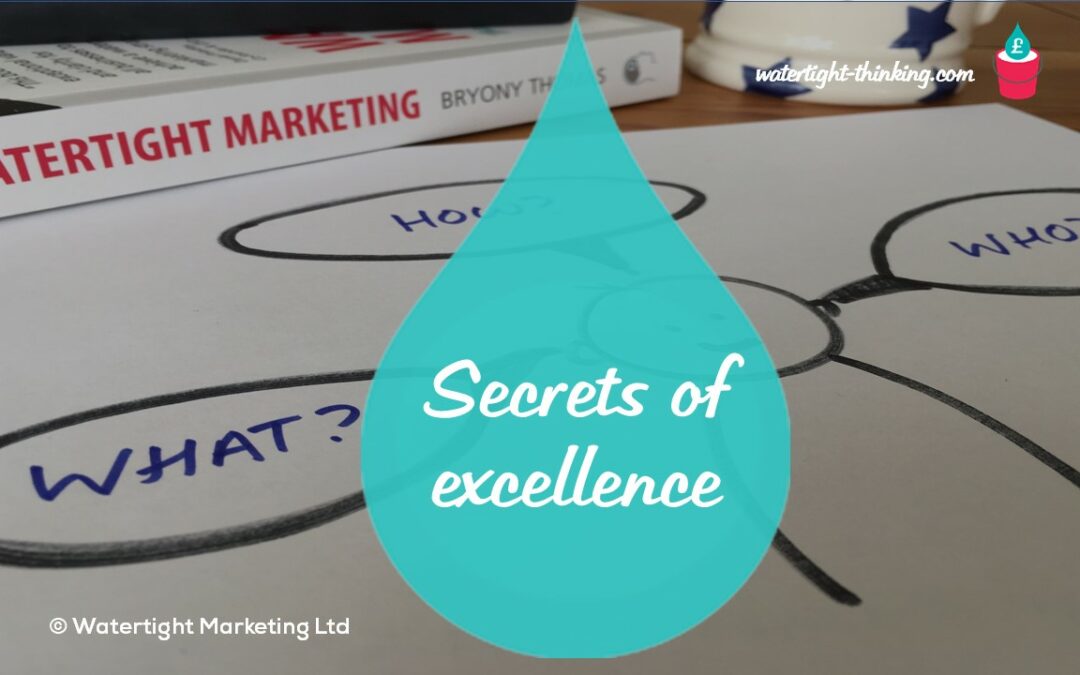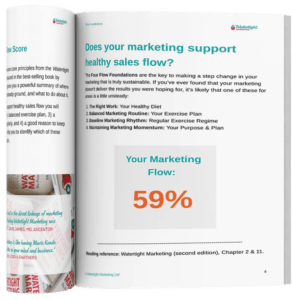Reading Time: 5 Minutes
A few weeks back we ran a webinar delving into the detail of our recently published research report. The title of the session was how marketing leaders create strategic and operational excellence. In this blog we look at four ways to do that. ~ Rachael Wheatley | MD, Watertight Business Thinking
You’ve probably seen a million books, blogs, emails, courses and pieces of advice relating to marketing strategy and operations – and how to make them more effective, more efficient or both. You’ve no doubt tried more than a few things that have been recommended and probably discovered that it’s not easy to apply any of these things in practice.
Businesses struggle to make good on the plentiful resources available. On one level it feels completely human not to do things we know will be good for us! In the real world, however, when you’re doing a real job on which your performance, and that of your team, is judged, you need to show progress. Knowing is not enough. Practical application is what will take you towards being excellent.
There are far fewer resources that link – and help you translate – strategy into effective operations. That is normally down to the lead marketer and, as our research shows, quite often doesn’t happen and indicates a real gap. This is where our Flow Foundations Floor Plan comes in. It gives you the thinking and tools to benchmark both strategy and operations, bridge that gap and identify what’s really going so that you can focus on the things that will have the most impact.
Every business is different. However, what our research shows is that there are common themes pointing to why marketing doesn’t work. The real secrets to marketing excellence can be found by doing four things:
- Translating strategic thinking into action
- Closing the gap between thinking and doing
- Communicating your plans internally to gain colleagues’ buy-in and engagement
- Realising opportunities.
Invest in translating strategic thinking into action
Achieving excellence is hard and very few get businesses there. In fact, from our research we found only 12% of businesses rated themselves green overall. Looking at those businesses, it was clear that one of the critical things that was responsible for their excellence was their strong strategic foundations. So how do you make sure your strategic strength and thinking drives practical actions?
Ask the right questions: what implications does this thinking or decision have on our business, for different teams including marketing? How does it impact and for whom? What do I need to put in place and what actions do we need to take to make sure our thinking becomes real? For instance, as a leadership team you might have discussed and agreed that you want to expand into a new sector or geography. This decision will have an impact on your marketing strategy and plans, financials (it could take longer to reach your revenue targets than other strategies) and operational resource (you need the set-up and processes in place to properly service this new segment).
Use that strategic thinking to guide your decisions, always referring back to it to keep the business on the right track.
Close the gap between thinking and doing
It’s quite common in our experience to see a gap between knowing and doing in all sorts of areas. Over recent months, we’ve worked with two clients who were both clear about their focus audience. They had taken the trouble of characterising these people, they knew who they were and how to reach them. They knew the factors that were involved in their customers’ decision and what they were selling to them. This had all been agreed at management team level.
However, it transpired that in neither case was this what was actually happening in practice. Their sales teams were pursuing the easiest to win or biggest potential customers which often didn’t correlate with those focus clients. This is a classic example of the gap between thinking and doing. The need for short-term wins undermines the strategic thinking.
If you know who your audience is and the value proposition that speaks to their needs, make sure this is threaded through your sales and marketing plans and into your operations, service and finance teams. If you’ve done the work to agree your vision and values, make sure these are communicated to everyone in the business with examples of what they mean in practice, what success means and the behaviours you expect if people are demonstrating those values. If you’ve done the research and work to map out your customers’ decision journey and understand it takes 18 months for them to buy from you, don’t rush their decision, thinking you’ll win that business sooner.
Focus on the internal communication of your plans
From our research, we found that this was a key missing piece. We looked at the questions in our marketing fitness test that had anything to do with internal communication, engagement with colleagues, needing buy-in from or discussion with others in the business. Then we analysed how those questions were answered amongst the 500+ companies who had completed the test. What we found was that these questions all scored lower than any relating to external communications.
It is impossible for marketing to be truly effective if it works in a silo, if it’s not seen as central to a business’s success. To ensure that doesn’t happen, you need to communicate your plans internally, gain feedback from people and involve them in discussions. The more you can create that internal alignment, the closer to excellence you will get.
Realise the opportunities
Opportunities for most businesses are not being realised. Often, this is because marketing is pigeon-holed or because a business has a very narrow definition of marketing. Typically marketing is seen as operating only at what we call the top of the funnel activities – those that generate awareness and pique interest. We extend marketing to include support for all stages of a customer’s decision journey, not just lead generation and brand awareness. We see it as crucial in supporting and working collaboratively with sales people, customer services and account management. If this isn’t happening in your business, work out ways in which you can bring different teams together.
It is this holistic view of marketing that we believe helps businesses to better realise the opportunities that are in front of them and to ensure the marketing they have supports them to increase both the quantity and quality of happy customers.
Of course, marketing excellence isn’t achieved overnight. We have a saying: functional is a milestone en route to world class. Aim for gold, and recognise you’ll get there through incremental improvements, each building on the last, over time. Be guided in this journey by these four secrets to steer you towards excellence.
Download the research paper here

Subscribe to the CMO Toolkit
Would you like to get your hands on the tools, frameworks, templates, workshop packs, slides, and analysis tools we use with our clients? It’s all waiting for you.

Rachael Wheatley
Managing Director, Watertight Thinking
Rachael brings over 30 years’ of marketing experience, with a particular focus on building and developing effective marketing teams that are able to act as a strategic driving force across an organisation. She has worked with Watertight since 2014 as a Master Practitioner and joined the business as MD in 2022.


